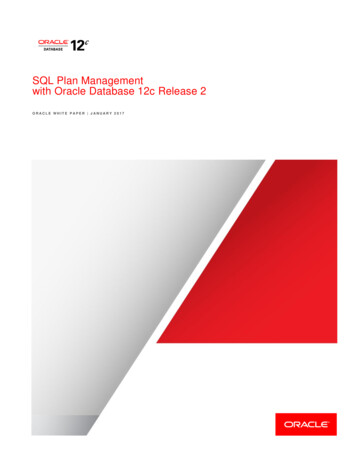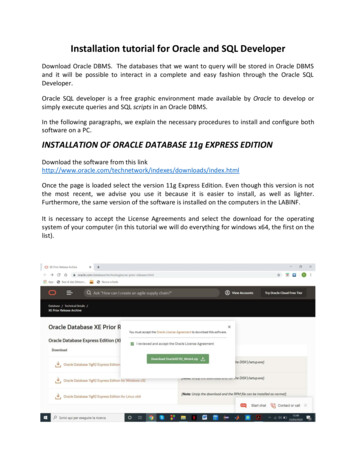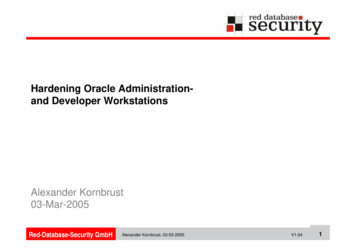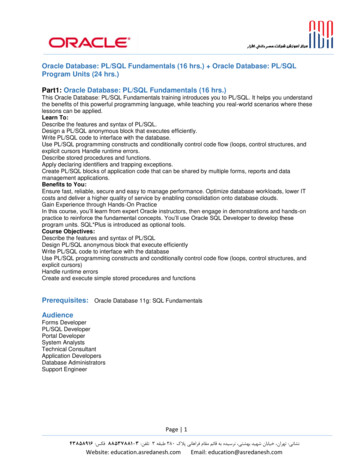
Transcription
SQL Plan Managementwith Oracle Database 12c Release 2ORACLE WHITE PAPER JANUARY 2017
Table of ContentsIntroduction1SQL Plan Management2Interaction with Other Performance Features12SQL Plan Management Use-Cases16Conclusion20References21SQL PLAN MANAGEMENT WITH ORACLE DATABASE 12C RELEASE 2
IntroductionThe performance of any database application heavily relies on consistent query execution. While theOracle Optimizer is perfectly suited to evaluate the best possible plan without any user intervention, aSQL statement’s execution plan can change unexpectedly for a variety of reasons including regathering optimizer statistics, changes to the optimizer parameters or schema/metadata definitions.The lack of a guarantee that a changed plan will always be better leads some customers to freeze theirexecution plans (using stored outlines) or lock their optimizer statistics. However, doing so preventsthem from ever taking advantage of new optimizer functionality (like new access paths), that wouldresult in improved plans. An ideal solution to this conundrum would preserve the current executionplans amidst environment changes, yet allow changes only for better plans.SQL Plan Management (SPM) provides such a framework and allows for complete controlled planevolution. With SPM the optimizer automatically manages execution plans and ensures that onlyknown or verified plans are used. When a new plan is found for a SQL statement, it will not be useduntil it has been verified to perform better than the current plan.This paper provides an in-depth explanation of how SPM works and why it should be a critical part ofevery DBAs toolkit. The paper is divided into three sections. The first section describes thefundamental aspects of SPM and how they work together to provide plan stability and controlled planevolution. It then discusses how SPM interacts with other Oracle Database features that influence theoptimizer plan selection. The final section provides a more step-by-step guide on how to use SPM toensure consistent database and application performance during some of the more daunting tasks of aDBA, including upgrades.1 SQL PLAN MANAGEMENT WITH ORACLE DATABASE 12C
SQL Plan ManagementIntroductionSQL plan management (SPM) ensures that runtime performance will not degrade due to execution plan changes.To guarantee this, only accepted execution plans are used; any plan evolution that does occur is tracked andevaluated at a later point in time, and only accepted if the new plan shows a noticeable improvement in runtime.SQL Plan Management has three main components:» Plan Capture:» Creation of SQL plan baselines that store accepted execution plans for all relevant SQL statements. SQLplan baselines are stored in the SQL management base in the SYSAUX tablespace.» Plan Selection:» Ensures only accepted execution plans are used for statements with a SQL plan baseline and records anynew execution plans found for a statement as unaccepted plans in the SQL plan baseline.» Plan Evolution:» Evaluate all unaccepted execution plans for a given statement, with only plans that show a performanceimprovement becoming accepted plans in the SQL plan baseline.SQL Management BaseThe SQL management base (SMB) is a logical repository in the data dictionary, physically located in the SYSAUXtablespace. In the context of SPM, it stores the following structures:» SQL Plan History» The SQL plan history is the set of SQL execution plans generated for SQL statements over time.» The history contains both SQL plan baselines and unaccepted plans.» SQL Plan Baselines» A SQL plan baseline is an accepted plan that the optimizer is allowed to use for a SQL statement. In thetypical use case, the database accepts a plan into the plan baseline only after verifying that the planperforms well.» SQL Statement Log» A series of query signatures used to identify queries that have been executed more than once duringautomatic plan capture (see below).Plan CaptureFor SPM to become active, the SQL management base must be seeded with a set of acceptable execution plans,which will become the SQL plan baseline for the corresponding SQL statements. There are two different ways topopulate the SQL management base: automatically or manually.Automatic Plan CaptureAutomatic plan capture is enabled by setting the init.ora parameterOPTIMIZER CAPTURE SQL PLAN BASELINES to TRUE (default FALSE). When enabled, a SQL plan baselinewill be automatically created for any repeatable SQL statement provided it doesn’t already have one. Repeatablestatements are SQL statements that are executed more than once during the capture period. To identify repeatableSQL statements, the optimizer logs the SQL signature (a unique SQL identifier generated from the normalized SQLtext) of each SQL statement executed the first time it is compiled. The SQL signatures are stored in the SQLstatement log in the SQL management base.2 SQL PLAN MANAGEMENT WITH ORACLE DATABASE 12C
If the SQL statement is executed again, the presence of its signature in the statement log will signify it to be arepeatable statement. A SQL plan baseline is created for the repeatable statements, which includes all of theinformation needed by the optimizer to reproduce the current cost-based execution plan for the statement, such asthe SQL text, outline, bind variable values, and compilation environment. This initial plan will be automaticallymarked as accepted. If some time in the future a new plan is found for this SQL statement, the execution plan will beadded to the SQL plan baseline but will be marked unaccepted.Automatic plan capture is not enabled by default as it would result in a SQL plan baseline being created for everyrepeatable SQL statement executed on the system, including all monitoring and recursive SQL statements. On anextremely busy system this could potentially flood the SYSAUX tablespace with unnecessary SQL plan baselines.Note also that the first plan captured for each statement is automatically accepted, even if it isn’t the mostperformant plan. Automatic plan capture should therefore only be enabled when the default plans generated forcritical SQL statements are performing as expected.Oracle Database 12c Release 2 adds the capability to limit which SQL statements are captured using filters. Forexample, Figure 1 shows how to target a specific database schema and view the configuration settings inDBA SQL MANAGEMENT CONFIG:Figure 1: Setting and viewing the SPM configuration informationManual Plan CaptureManually loading plans into SPM is the most common method to populate SQL plan baselines and is especiallyuseful when a database is being upgraded from a previous version, or when a new application is being deployed.Manual loading can be done in conjunction with or instead of automatic plan capture, and can be done for a singlestatement or all of the SQL statements in an application. Execution plans that are manually loaded are automaticallyaccepted to create new SQL plan baselines, or added to existing SQL plan baselines as accepted plans. Plans canbe manually loaded from four different sources, using either the functions in the DBMS SPM package or throughOracle Enterprise Manager (EM):» From a SQL Tuning Set» From the cursor cache» From the AWR repository (new to Oracle Database 12c Release 2)» Unpacked from a staging table» From existing stored outlinesFrom a SQL Tuning SetA SQL tuning set (STS) is a database object that includes one or more SQL statements, their execution statisticsand execution context (which can include the execution plan). You can also export SQL tuning sets from a databaseand import them into another. One or more plans can be loaded into SPM from an STS using the PL/SQL procedureDBMS SPM.LOAD PLANS FROM SQLSET. The plans manually loaded from the STS will be automaticallyaccepted.3 SQL PLAN MANAGEMENT WITH ORACLE DATABASE 12C
From the Cursor CachePlans can be loaded directly from the cursor cache into SQL plan baselines. By applying a filter on the SQLstatement text, module name, SQL ID or parsing schema, a SQL statement or set of SQL statements can beidentified and their plans captured using the PL/SQL procedureDBMS SPM.LOAD PLANS FROM CURSOR CACHE.From the AWR RepositoryOracle Database 12c Release 2 adds the capability to capture SQL plan baselines directly from the AWR repositoryusing the PL/SQL procedure DBMS SPM.LOAD PLANS FROM AWR. Plans can be loaded between a specifiedbegin and end AWR snapshot and, in common with the other manual approaches, filters can be used to limit whichSQL statements are selected to be stored as SQL plan baselines.Copying SQL Plan Baselines Using a Staging TableJust as it is possible to transfer optimizer statistics from one database system to another, it is possible to transferSQL plan baselines via a staging table. SQL plan baselines can be packed into a staging table, on the sourcesystem, using the PL/SQL procedure DBMS SPM.PACK STGTAB BASELINE. The staging table can then beexported from one system and imported into another, using a database utility like Data Pump. Once the stagingtable is imported, the SQL plan baselines can be unpacked from the staging table using the PL/SQL procedureDBMS SPM.UNPACK STGTAB BASELINE. Once unpacked, the SQL plan baselines will be active and will beused the next time the corresponding SQL statements are executed.Figure 2: Copying SQL plan baselines from one database to another.From Existing Stored OutlinesIn earlier releases of Oracle Database, stored outlines were the only mechanism available to preserve an executionplan. With stored outlines, only one plan could be used for a given SQL statement, and no plan evolution waspossible. Stored outlines were deprecated in Oracle Database 11g, and it is strongly recommended that any existingstored outlines be migrated to SPM.4 SQL PLAN MANAGEMENT WITH ORACLE DATABASE 12C
Stored outlines can be migrated to SQL plan baselines using the PL/SQL procedureDBMS SPM.MIGRATE STORED OUTLINE. You can specify stored outlines to be migrated based on their name,category, or associated SQL text, or you can simply migrate all stored outlines in the system.Capturing Additional Plans for Existing BaselinesRegardless of which method you use to initially create a SQL plan baseline, any subsequent new plan found for thatSQL statement will be added to the plan baseline as an unaccepted plan. This behavior is not dependent on theinitialization parameter OPTIMIZER CAPTURE SQL PLAN BASELINES and will occur even if this parameter isset to FALSE (the default). These newly added plans will not be used until the plan has been verified to performbetter than the best existing accepted plan in the SQL plan baseline.Plan SelectionEach time a SQL statement is compiled, the optimizer first uses the traditional cost-based search method to build abest-cost plan. If the initialization parameter OPTIMIZER USE SQL PLAN BASELINES is set to TRUE (the defaultvalue), then before the cost based plan is executed the optimizer will check to see if a SQL plan baseline exists forthis statement. SQL statements are matched to SQL plan baselines using the signature of the SQL statement. Asignature is a unique SQL identifier generated from the normalized SQL text (uncased and with whitespacesremoved). This is the same technique used by SQL profiles and SQL patches. This comparison is done as an inmemory operation, thus introducing no measurable overhead to any application.If any accepted SQL plan baselines exists for the SQL statement, the generated cost-based plan is compared toplans in the SQL plan baseline (a match is detected using plan hash values). If a match is found, and the SQL planbaseline is in an accepted state, the optimizer proceeds with this plan. Otherwise, if no match is found, the newlygenerated plan is added to the SQL plan baseline as an unaccepted plan. It will have to be verified before it can beaccepted. Instead of executing the newly generated plan, the optimizer will cost each of the accepted plans for theSQL statement and pick the one with the lowest cost (note that a SQL plan baseline can have more than oneaccepted plan for a given statement). However, if a change in the system (such as a dropped index) causes all ofthe accepted plans to become non-reproducible, the optimizer will use the newly generated cost-based plan and willstore this plan in the SQL plan history as an unaccepted plan.Figure 3: Flowchart of how plan selection works.5 SQL PLAN MANAGEMENT WITH ORACLE DATABASE 12C
It is also possible to influence the optimizer’s choice when it is selecting from the plans in a SQL plan baseline. Oneor more plans in the SQL plan baseline can be marked as fixed. Fixed plans indicate to the optimizer that they arepreferred. The optimizer will select the fixed plan with the lowest cost unless none of the fixed plans arereproducible. In that case, the optimizer will cost the remaining (accepted and non-fixed) plans in the SQL planbaselines, and select the one with the lowest cost.Note that costing an existing plan is not nearly as expensive as a full cost-based optimization. The optimizer is notlooking at all possible alternatives, but at specific ones indicated by the plan, like a given access path.You should also be aware that no new plans are added to a SQL plan baseline that contains a fixed plan, even if anew cost-based plan is found at parse.Plan EvolutionWhen the optimizer finds a new plan for a SQL statement, the plan is added to the SQL plan baseline as anunaccepted plan that needs to be verified before it can become an accepted plan. Verification is the process ofcomparing the execution performances of the non-accepted plan and the best accepted plan (plan with the lowestcost). The execution is performed using the conditions (e.g., bind values, parameters, etc.) in effect at the time theunaccepted plan was added to the SQL plan baseline. If the unaccepted plan's performance is better, it will beautomatically accepted otherwise it will remain unaccepted but its LAST VERIFIED attribute will be updated withthe current timestamp. Automatic plan evolution in Oracle Database 12c (see below) will consider the plan again ifat least 30 days has passed since it was last verified (and as long as the SQL is still being executed). You canprevent this by disabling the plan with dbms spm.alter sql plan baseline, but it is recommended that you leave itenabled and continue to allow automatic evolution to prioritize which execution plans to verify. After all, if changesare made to a system then an alternative plan may prove to be beneficial.The performance criteria used by the evolve process are the same as those used by the SQL Tune Advisor andSQL Performance Analyzer. An aggregate performance statistic is calculated for each test execution based theelapse time, CPU time and buffer gets. The performance statistics are then compared and if the new plan shows aperformance improvement of 1.5 over the existing accepted plan, then it will be accepted.6 SQL PLAN MANAGEMENT WITH ORACLE DATABASE 12C
The results of the evolve process are recorded in the data dictionary and can be viewed any time using theDBMS SPM.REPORT EVOLVE TASK function.Figure 4: Example evolve reportAn evolve report describes which plans were tested with the actions performed, and a side-by-side comparison ofthe performance criteria of each execution. It also has a findings section that clearly explains what happened duringthe verification process and whether or not the new plan should be accepted. Finally, there is a recommendationssection that gives detailed instructions on what to do next, including the necessary syntax. In the evolve reportshown in Figure 4, the unaccepted test plan performed more than 1.5 times better than the current accepted planand the recommendation is therefore to accept this plan so that it will be stored as a new SQL plan baseline.As with plan capture, plan evolution can be done automatically or manually.Automatic Plan EvolutionFrom Oracle Database 12c Release 1 onward, automatic plan evolution is done by the SPM Evolve Advisor. TheSPM Evolve Advisor is an AutoTask (SYS AUTO SPM EVOLVE TASK), which operates during the nightlymaintenance window and automatically runs the evolve process for unaccepted plans in SPM. The AutoTask ranksall unaccepted plans in SPM (newly found plans ranking highest) and then runs the evolve process for as manyplans as possible before the maintenance window ends.All of the unaccepted plans that perform better than the existing accepted plan in their SQL plan baseline areautomatically accepted. However, any unaccepted plans that fail to meet the performance criteria remainunaccepted and their LAST VERIFIED attribute will be updated with the current timestamp. The AutoTask will notattempt to evolve an unaccepted plan again for at least another 30 days and only then if the SQL statement is active(LAST EXECUTED attribute has been updated). The results of the nightly evolve task can be viewed using theDBMS SPM.REPORT AUTO EVOLVE TASK function.Manual Plan EvolutionAlternatively, it is possible to evolve an unaccepted plan manually using Oracle Enterprise Manager or the suppliedpackage DBMS SPM. From Oracle Database 12c Release 1 onwards, the original SPM evolve function(DBMS SPM.EVOLVE SQL PLAN BASELINE) has been deprecated in favor of a new API that calls the SPM7 SQL PLAN MANAGEMENT WITH ORACLE DATABASE 12C
evolve advisor. Figure 5 shows the steps needed to invoke the SPM evolve advisor. It is typically a three stepprocesses beginning with the creation of an evolve task. Each task is given a unique name, which enables it to beexecuted multiple times. Once the task has been executed, you can review the evolve report by supplying the taskname and execution name to the DBMS SPM.REPORT EVOLVE TASK function.Figure 5: Invoking the SPM evolve advisor manuallyWhen the SPM evolve advisor is manually invoked, the unaccepted plan(s) is not automatically accepted even if itmeets the performance criteria. The plans must be manually accepted using theDBMS SPM.ACCEPT SQL PLAN BASELINE procedure. The evolve report contains detailed instructions,including the specific syntax, to accept the plans.Figure 6: Manually accepting a planNote that the ‘Administer SQL Management Object’ privilege is required to manually evolve plans.8 SQL PLAN MANAGEMENT WITH ORACLE DATABASE 12C
Managing and Monitoring SQL Plan BaselinesAll aspects of managing and monitoring SQL plan baselines can be done through Oracle Enterprise Manager or thePL/SQL packages DBMS SPM, DBMS XPLAN and the DBA view DBA SQL PLAN BASELINES.Oracle Enterprise ManagerTo get to the SQL plan baseline page:» Access the Database Home page in Enterprise Manager.» At the top of the page, click on the performance tab and select the SQL Plan Control from the drop down list.» The SQL Plan Control page appears.» At the top of the page, click on the SQL Plan Baseline table to display the SQL plan baseline subpage.Figure 7: SPM home page in Oracle Enterprise Manager9 SQL PLAN MANAGEMENT WITH ORACLE DATABASE 12C
Initialization ParametersThere are two init.ora parameters that control SPM.OPTIMIZER CAPTURE SQL PLAN BASELINES Controls the automatic creation of new SQL plan baselines forrepeatable SQL statements. This parameter is set to FALSE by default. Note it is not necessary for this parameter tobe set to TRUE in order to have a newly found plan added to an existing SQL plan baseline.If a SQL statement has multiple plans then all of them will be captured, but only the first will be accepted. If you donot which to use plan baselines during auto capture, you can set optimizer use sql plan baselines to FALSE.OPTIMIZER USE SQL PLAN BASELINES controls the use of SQL plan baselines. When enabled, the optimizerchecks to see if the SQL statement being compiled has a SQL plan baseline before executing the cost-based plandetermined during parse. If a SQL plan baseline is found and the cost-based plan is an accepted plan in thatbaseline, then the optimizer will go ahead and use that plan. However, if a SQL plan baseline is found and the costbased plan is not an accepted plan in that baseline, then it will be added to the SQL plan baseline but not executed.The optimizer will cost each of the accepted plans in the SQL plan baseline and pick the one with the lowest cost.This parameter is TRUE by default. When set to FALSE the optimizer will only use the cost-based plan determinedduring parse (SQL plan baselines will be “ignored”) and no new plans will be added to existing SQL plan baselines.These parameter values can be changed on the command line either at a session or system level using an altersession or alter system command. It is also possible to adjust the parameter setting on the upper left handside of the main SQL plan baseline page (the Settings section) in Enterprise Manager.Managing the space consumption of SQL Management BaseThe statement log and all SQL plan baselines are stored in the SQL Management Base. The SQL ManagementBase is part of the database dictionary, stored in the SYSAUX tablespace; this is the tablespace for all internalpersistent information outside the dictionary and cannot be changed. By default, the space limit for the SQLManagement Base is no more than 10% of the size of the SYSAUX tablespace. However, it is possible to change thelimit to any value between 1% and 50% using the PL/SQL procedure DBMS SPM.CONFIGURE or EnterpriseManager. A weekly background process measures the total space occupied by the SQL Management Base, andwhen the defined limit is exceeded, the process will generate a warning in the alert log, for example:SPM: SMB space usage (99215979367) exceeds 10.000000% of SYSAUX size (1018594954366).Reaching the limit will not prevent new plans from being added to existing SQL plan baselines or new SQL planbaselines from being added to the SQL Management Base.There is also a weekly scheduled purging task (operated by MMON) that manages the disk space used by SPMinside the SQL Management Base. The task runs automatically and purges any plans that have not been used formore than 53 weeks, by running the DBMS SPM.DROP SQL PLAN BASELINE function on each one. It ispossible to change the unused plan retention period using either using DBMS SPM.CONFIGURE or EnterpriseManager; its value can range from 5 to 523 weeks (a little more than 10 years).The SQL Management Base is stored entirely within the SYSAUX tablespace, so SPM will not be used if thistablespace is not available.10 SQL PLAN MANAGEMENT WITH ORACLE DATABASE 12C
Monitoring SQL plan baselinesThe view DBA SQL PLAN BASELINES displays information about the current SQL plan baselines in thedatabase. The same information is displayed at the bottom of the SQL plan baseline page in Oracle EnterpriseManager.Figure 8: Monitoring SQL plan baselines using the dictionary view DBA SQL PLAN BASELINESIn the example in Figure 8, the same SQL statement has two plans in its SQL plan baseline. Both plans wereautomatically captured but only one of the plans (SQL PLAN c2bg7p288wk7b18498f6e) will be used by theoptimizer, as it is the only plan that is both enabled and accepted. The other plan is an unaccepted plan, whichmeans it won’t be used until it has been verified.To check the detailed execution plan for any SQL plan baseline, click on the plan name on the SQL plan baselinepage in Enterprise Manager or use the procedure DBMS XPLAN.DISPLAY SQL PLAN BASELINE. In OracleDatabase 11g, executing this function will trigger a compilation of the SQL statement using the information storedabout the plan in the SQL Management Base. This is also the case in Oracle Database 12c if the plan was createdin Oracle Database 11g. From Oracle Database 12c Release 1 onwards, Oracle captures the actual plan rowswhen adding a new plan to SPM. This means that in Oracle Database 12c, the DISPLAY SQL PLAN BASELINEwill display the actual plan recorded when the plan was added to the SQL plan baseline.Capturing the actual execution plans ensures that if a SQL plan baseline is moved from one system to another, theplans in the SQL plan baseline can still be displayed even if some of the objects used in it or the parsing schemaitself does not exist on the new system. This means that a plan can still be displayed even if it cannot bereproduced.Figure 9 shows the execution plan for the accepted plan from Figure 8. The plan shown is the actual plan that wascaptured when this plan was added to the SQL plan baseline because the attribute ‘Plan rows’ is set to ‘Fromdictionary’. For plays displayed based on an outline, the attribute ‘Plan rows’ is set to ‘From outline’.Figure 9: Displaying one of the accepted plans from a SQL plan baseline11 SQL PLAN MANAGEMENT WITH ORACLE DATABASE 12C
It is also possible to check whether a SQL statement is using a SQL plan baseline by looking in V SQL. If the SQLstatement is using a SQL plan baseline, the plan name, from the SQL plan baseline, will appear in thesql plan baseline column of V SQL. You can join the V SQL view to the DBA SQL PLAN BASELINES viewusing the plan name columns or use the exact matching signature column.Figure 10: Joining V SQL to DBA SQL PLAN BASELINESInteraction with Other Performance FeaturesSPM is not the only feature in the Oracle Database that influences the optimizer’s choice of execution plan. Thissection describes in detail how SPM interacts with the other plan-influencing features in the Oracle Database. Bearin mind that SPM is a very conservative approach for guaranteeing plan stability and that level of conservatismdoesn’t always allow other features to fully exert themselves.SQL Plan Baselines and Adaptive PlansAdaptive plans, introduced in Oracle Database 12c, enable the optimizer to defer the final plan decision for astatement until execution time. The optimizer instruments its chosen plan (the default plan) with statistics collectorsso that it can detect at runtime, if its cardinality estimates differ greatly from the actual number of rows seen by theoperations in the plan. If there is a significant difference, then the plan or a portion of it will be automatically adaptedto avoid suboptimal performance on the first execution of a SQL statement.More detail can be found in Reference 1, Optimizer with Oracle Database 12c Release 2.12 SQL PLAN MANAGEMENT WITH ORACLE DATABASE 12C
SPM Plan Capture and Adaptive PlansWhen automatic plan capture is enabled and a SQL statement that has an adaptive plan is executed, only the finalplan used will be captured in the SQL plan baseline.However, if the optimizer finds a new adaptive plan for a SQL statement that has an existing SQL plan baseline,then only the initial or default plan will be recorded in the SQL plan baseline. The recorded plan will be markedadaptive, so the optimizer can take that into consideration during the evolve process.Figure 11: DBA SQL PLAN BASELINES shows a newly added plan with the adaptive attribute set to TRUESPM Plan Selection and Adaptive PlansAccepted plans in a SQL plan baseline are never adaptive. Thus, the plan selected for a SQL statement with a SQLplan baseline will never be adaptive.SPM Plan Evolution and Adaptive PlansWhen evolving a plan that has been marked adaptive, the optimizer determines all of the possible subplans beforethe test executions begin. Once executing, the optimizer will decide which subplan to use based on the executionstatistics recorded in the statistics collectors. The performance of the final plan used during the test execution iscompared to the existing accepted plan, in the SQL plan baseline. If the final plan performs better than the existingaccepted plan, it will be added to the plan baseline as an accepted plan, and will replace the non-accepted adaptiveplan that was verified. Since the newly added plan is the final plan, it is no longer marked adaptive.SQL Plan Baselines and Adaptive Cursor SharingSince Oracle Database 11g, the optimizer has allowed multiple execution plans to be used for a single statementwith bind variables at the same time. This functionality is called Adaptive Cursor Sharing (ACS) 1and relies on themonitoring of execution statistics to ensure the correct plan is used for each bind value.On the first execution the optimizer will peek the bind value(s) and determine the execution plan based on the bindvalue’s selectivity. The cursor will be marked bind sensitive if the optimizer believes the optimal plan may dependon the value of the bind variable (for example, a histogram is present on the column or the predicate is a range, or , ). When a cursor is marked bind sensitive, Oracle monitors the behavior of the cursor using different bind values,to determine if a different plan is called for.Oracle’s adaptive cursor sharing is built on an optimistic approach: if a different bind value is used in a subsequentexecution, the optimizer will use the existing cursor and execution plan because Oracle initially assumes the cursorcan be shared. However, the execution statistics for the new bind value will be recorded and compared to theexecution statistics for the previous value. If Oracle determines that the new bind value caused the data volumes1 More information on Adaptive Cursor Sharing can be found in Closing the Query Loop in Oracle 11g13 SQL PLAN MANAGEMENT WITH ORACLE DATABASE 12C
manipulated by the query to be significantly different it “adapts” and hard parses based on the new bind value on itsnext execution and the cursor is marked bind-aware. Each bind-aware cursor is associated with a selectivity rangeof the bind so that the cursor is only shared for a statement when the bind value in the statement is believed to fallwithin the range.When another new bind value is used, the optimizer tries to find a cursor it thinks will be a good fit, based onsimilarity in the bind value's selectivity. I
5 SQL PLAN MANAGEMENT WITH ORACLE DATABASE 12C Stored outlines can be migrated to SQL plan baselines using the PL/SQL procedure DBMS_SPM.MIGRATE_STORED_OUTLINE. You can specify stored outlines to be migrated based on their name, category, or associated SQL text, or you can simply migrate all stored outlines in the system.File Size: 902KB










